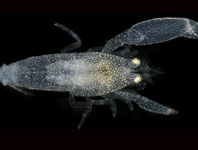Abstract
We report finding Strumigenys thaxteri Wheeler in the Amazonian foothills of southeastern Ecuador, over 2000 km to the west of previously known records for the species in Trinidad and Guyana. Field observations suggest it is a sit and wait ambush predator that captures insects that alight on the vegetation upon which they position themselves. Once prey is subdued they descend with it to ground level, where they presumably nest. Their massive mandibles, robust claws, dense body cover of long silky hairs, and sting may all contribute to detecting, trapping, and subduing larger sized, flying prey. This type of predation is hitherto unreported for the genus. Strumigenys reticeps (Kempf), an apparently closely related species from southern Brazil, may share the same behavior but its key morphological traits are of a lesser degree of development than in S. thaxteri. Both species are redescribed and their morphological variability is discussed. High resolution images of both species are provided. The more frequent use of vegetation beating for ant-collecting is urged. Strumigenys lojanensis Lattke & Aguirre is synonymized as a junior synonym of S. onorei Baroni Urbani & De Andrade.
References
ADMAC (2016) Ant Diversity of the MesoAmerican Corredor. Reports: 2016 Mexico. Available from: https://sites.google.com/site/admacsite/reports/2016-mexico (accessed 12 December 2016)
AntWeb (2016) Label View: Specimen CASENT0900194 Strumigenys thaxteri. Photo by Zach Lieberman. Available from: https://www.antweb.org/bigPicture.do?name=casent0900194&shot=l&number=1(accessed 14 November 2016)
Azorsa, F. & Sosa-Calvo, J. (2008) Description of a remarkable new species of ant in the genus Daceton Perty (Formicidae: Dacetini) from South America. Zootaxa, 1749, 27–38.
Baroni Urbani, C. & De Andrade, M.L. (2007) The ant tribe Dacetini: limits and constituent genera, with descriptions of new species (Hymenoptera, Formicidae). Annali del Museo Civico di Storia Naturale Giacomo Doria, 99, 1–191.
Billen, J., Al-Khalifa, M.S. & Silva, R.R. (2017) Pretarsus structure in relation to climbing ability in the ants Brachyponera sennaarensis and Daceton armigerum. Saudi Journal of Biological Sciences, 24, 830–836.
https://doi.org/10.1016/j.sjbs.2016.06.007Bolton, B. (1995) A new general catalogue of the ants of the world. Harvard University Press, Cambridge, MA, 504 pp.
Bolton, B. (1999) Ant genera of the tribe Dacetonini (Hymenoptera: Formicidae). Journal of Natural History, 33, 1639–1689.
https://doi.org/10.1080/002229399299798Bolton, B. (2000) The ant tribe Dacetini. Memoirs of the American Entomological Institute, 65, 1–1028.
Bolton, B. (2017) An online catalog of the ants of the world. Available from: http://antcat.org (accessed 01 November 2017)
Brown, W.L. Jr. (1953) Revisionary studies in the ant tribe Dacetini. American Midland Naturalist, 50, 1–137.
https://doi.org/10.2307/2422158Dejean, A. (1982) Etude éco-éthologique de la prédation chez les fourmis du genre Smithistruma (Formicidae-Myrmicinae-tribu des Dacetini)—I. Effets du milieu sur le choix des proies chez Smithistruma truncatidens Brown. International Journal of Tropical Insect Science, 3 (4), 245–249.
https://doi.org/10.1017/S1742758400001971Dejean, A., Solano, P.J., Ayroles, J., Corbara, B. & Orivel, J. (2009) Arboreal ants build traps to capture prey. Nature, 434, 973.
https://doi.org/10.1038/434973a
Dejean, A., Leroy, C., Corbara, B., Roux, O., Céréghino, R., Orivel, J. & Boulay, R. (2010) Arboreal ants use the 'Velcro Principle' to capture very large prey. PLoS ONE, 5 (6), e11331.
https://doi.org/10.1371/journal.pone.0011331Dejean, A., Delabie, J.H.C., Corbara, B., Azémar, F., Groc, S. & Orivel, J. (2012) The Ecology and Feeding Habits of the Arboreal Trap-Jawed Ant Daceton armigerum. PLoS ONE, 7 (5), e37683.
https://doi.org/10.1371/journal.pone.0037683
Gonzalez-Bellido, P.T., Wardill, T.J. & Juusola, M. (2011) Compound eyes and retinal information processing in miniature dipteran species match their specific ecological demands. Proceedings of the National Academy of Science U.S.A., 108 (10), 4224–4229.
https://doi.org/10.1073/pnas.1014438108
Kaufmann, E., Malsch, A.K.F., Erle, M. & Maschwitz, U. (2003) Compound nesting of Strumigenys sp. (Myrmicinae) and Diacamma sp. (Ponerinae), and other nesting symbioses of myrmicine and ponerine ants in Southeast Asia. Insectes Sociaux, 50, 88–97.
https://doi.org/10.1007/s000400300014
Kempf, W.W. (1959) Two new species of Gymnomyrmex Borgmeier, 1954 from southern Brazil, with remarks on the genus (Hymenoptera, Formicidae). Revista Brasileira de Biologia, 19, 337–344.
Kempf, W.W. (1969) Miscellaneous studies on Neotropical ants. V. (Hymenoptera, Formicidae). Studia Entomologica, 12, 273–296.
Lattke, J.E. & Aguirre, N. (2015) Two new Strumigenys F. Smith (Hymenoptera: Formicidae: Myrmicinae) from montane forests of Ecuador. Sociobiology, 62, 175–180.
https://doi.org/10.13102/sociobiology.v62i2.175-180.Lattke, J. & Goitía, W. (1997) El género Strumigenys (Hymenoptera: Formicidae) en Venezuela. Caldasia, 19, 367–396.
Masuko, K. (1984) Studies on the predatory biology of oriental dacetine ants (Hymenoptera: Formicidae) I. Some Japanese species of Strumigenys, Pentastruma, and Epitritus, and a malaysian Labidogenys, with special reference to hunting tactics in short-mandibulate forms. Insectes Sociaux, 31, 429.
https://doi.org/10.1007/BF02223658
Masuko, K. (2009) Studies on the predatory biology of Oriental dacetine ants (Hymenoptera: Formicidae) II. Novel prey specialization in Pyramica benten. Journal of Natural History, 43, 825–841.
https://doi.org/10.1080/00222930802610543Narendra, A., Ramirez-Esquivel, F. & Ribi, W.A. (2016) Compound eye and ocellar structure for walking and flying modes of locomotion in the Australian ant, Camponotus consobrinus. Scientific reports, 6, 22331.
https://doi.org/10.1038/srep22331Pflüger, H.-J. & Wolf, H. (2013) Developmental and activity-dependent plasticity of filiform hair receptors in the locust. Frontiers in Physiology, 4, 70.
https://doi.org/10.3389/fphys.2013.00070Rodríguez-Gironés, M.A., Gonzálvez, F.G., Llandres, A.L., Corlett, R.T. & Santamaría, L. (2013) Possible role of weaver ants, Oecophylla smaragdina, in shaping plant–pollinator interactions in South-East Asia. Ecology, 101 (4), 1000–1006.
https://doi.org/10.1111/1365-2745.12100Schindelin, J., Arganda-Carreras, I., Frise, E., Kaynig, V., Longair, M., Pietzsch, T., Preibisch, S., Rueden, C., Saalfeld, S., Schmid, B., Tinevez, J.Y., White, D.J., Hartenstein, V., Eliceiri, K., Tomancak, P. & Cardona, A. (2015) Fiji: An open-source platform for biological image-analysis. Nature Methods, 9, 676–82.
https://doi.org/10.1038/nmeth.2019Silva, T.S.R. (2014) Dacetini (Hymenoptera: Formicidae) da Mata Atlântica. Dissertation Universidade de São Paulo, 236 pp.
https://doi.org/10.11606/D.38.2014.tde-06092014-121842Sosa-Calvo, J., Schultz, T.R. & LaPolla, J.S. (2010) A review of the dacetine ants of Guyana (Formicidae: Myrmicinae). Journal of Hymenoptera Research, 19, 12–43.
Taylor, G.K. & Krapp, H.G. (2007) Sensory systems and flight stability: what do insects measure and why? Advances in Insect Physiology, 34, 231–316.
https://doi.org/10.1016/S0065-2806(07)34005-8Weiser, N. & Kaspari, M. (2006) Ecological morphospace of New World ants. Ecological Entomology, 31, 131–142.
https://doi.org/10.1111/j.0307-6946.2006.00759.xWheeler, W.M. (1916) Ants collected in Trinidad by Professor Roland Thaxter, Mr. F. W. Urich, and others. Bulletin of the Museum of Comparative Zoology, 60, 323–330.

